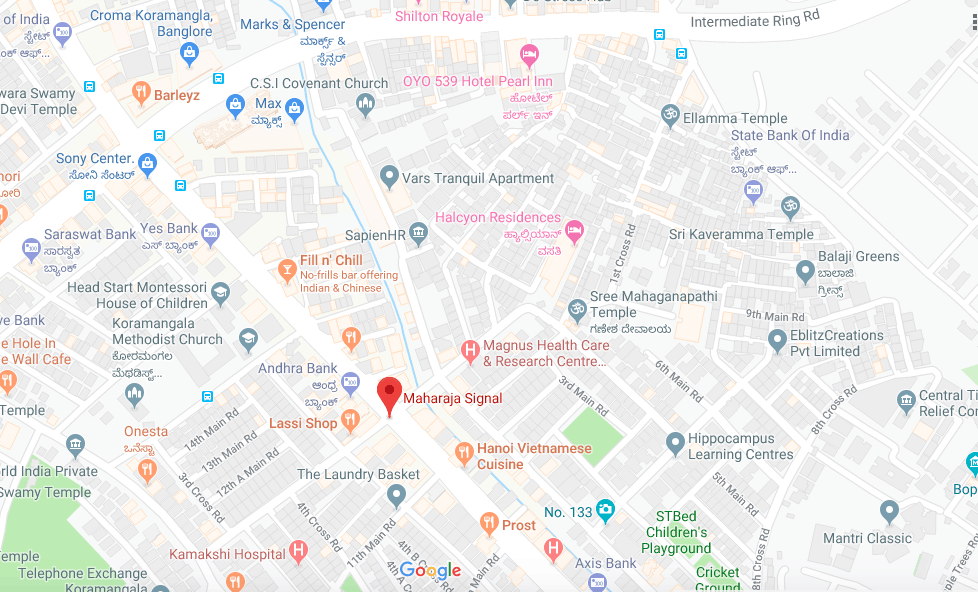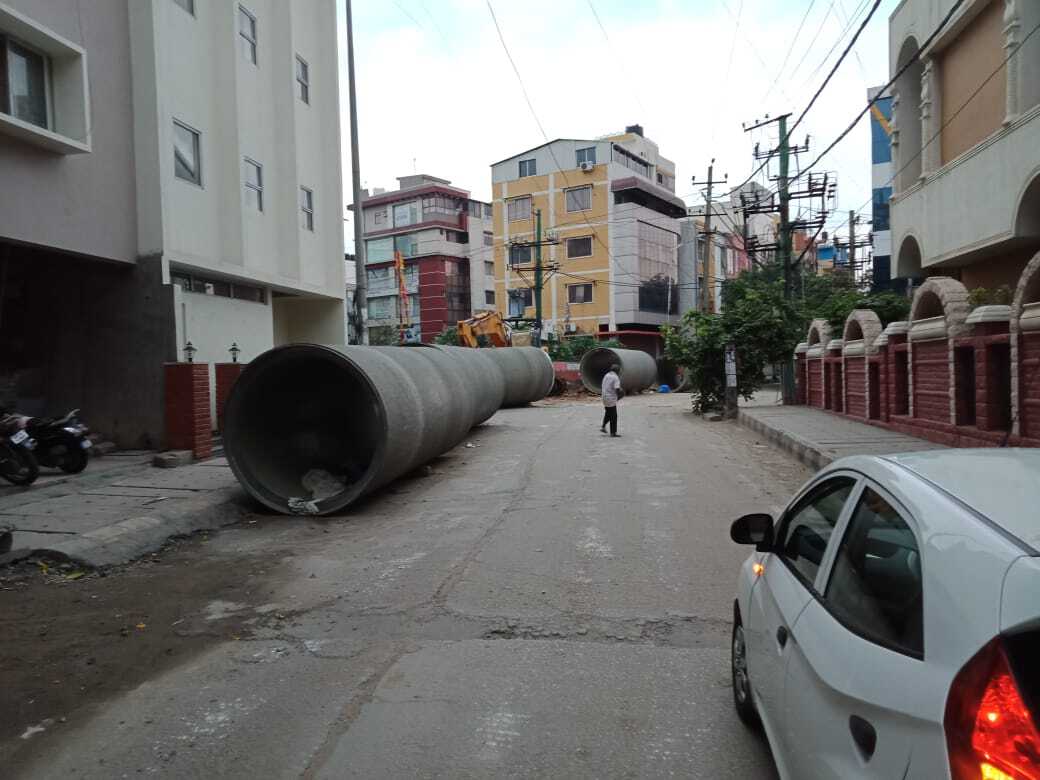One fine morning around mid-March, we, the residents of ST Bed Layout in Koramangala, suddenly found the Maharaja Junction bridge, our main link to the outside world, demolished. On asking around, we were given all kinds of reasons, none of which seemed to justify the demolition. The bridge, which covered a major storm water drain (SWD)/rajakaluve, used to be in good condition.
However, we were told that a new bridge was being built, and that it would be completed in around 45 days. We saw a lot of construction activity around the area, and hoped that BBMP would complete the work on time.
When we say the bridge was our “main link to the outside world”, we are not exaggerating. The bridge connects ST Bed Layout to the 80 ft road (Srinivagilu main road), along the stretch between Sony World Junction and Sarjapur main road. Its demolition has affected some 300 independent houses and several apartments in the layout.

The bridge at Maharaja Signal connects ST Bed Layout (to the right side of the signal) with the 80 ft main road. This stretch of 80 ft road connects Sony World junction (seen towards the top-right) to the Sarjapur main road (downwards)
There are three other roads that do link the layout to 80 ft road. But these are very narrow and barely motorable – the Srinivagilu village road and S T Bed 1st main road are quite narrow, and the Seva-in-action road is highly commercialised. Also, traffic along these roads has increased many fold over the years, and much of this is through-traffic to destinations beyond Koramangala.
Stranded in the layout
After the demolition, residents have been unable to cross the rajakaluve even by foot. So, some enterprising individuals came together to build a foot-bridge, that connects a vacant plot within the layout to the 80 ft road. But this foot-bridge was built most unprofessionally, and was hazardous. Once this was pointed out, there have been some efforts to upgrade it. But the bridge remains unsatisfactory, especially since school-going children may have to start using it soon.

The rickety foot-bridge built in the layout. Pic: Muralidhar Rao
In effect, entering and exiting ST Bed Layout has become a nightmare, particularly during peak hours. The traffic is worsened due to ongoing work on the Ejipura-Kendriya Sadan flyover in the Intermediate Ring Road (IRR), perpendicular to 80 ft road.
As if this was not enough, the BBMP simultaneously took up flood mitigation work at Nilgiri’s junction, which used to be another exit point for the layout residents. BBMP’s work here involves large-scale trenching, setting up cattle-trap cover (a grid of metal bars on the ground) etc. Hence, this option is also closed to us.
BWSSB comes up with its own plans
Two full months past the demolition and past the promise of completing the new bridge, we suddenly found huge 6-ft diameter pipes unloaded near the bridge construction site. On enquiring with BWSSB (Bangalore Water Supply and Sewerage Board) officials, we were told that the pipes were to be part of a new sewerage line.
This line would carry sewage from a pumping station in National Games Village (NGV) area to a new Sewage Treatment Plant (STP), under construction at Nagasandra. The STP, of 150 MLD (Million Litres per Day) capacity, will be located at a 90-acre site in Nagasandra, south of HAL airstrip, along the edge of Bellandur lake.

Pipes for laying the sewer line, unloaded at ST Bed Layout. Pic: Muralidhar Rao
A large portion of the new sewerage line is supposed to run beneath the base of the existing SWD. This is the case at Maharaja Junction bridge too. At the bridge site, the SWD bed itself is some 10 ft below ground level. To place the sewerage line even beneath this, the ground would have to be dug by another 10 ft or so.
That is, the excavation would be deep enough to endanger the stability of the bridge itself; and this is not the only bridge along the proposed pipeline. The line would also endanger the stability of the foundations of many tall buildings that have come up along both sides of the rajakaluve.
There are many engineers among ST Bed Layout residents, and for all of the verbal assurances given by the BWSSB engineering team, there is a serious sense of disquiet among them on the proposal.
The question is, why authorities couldn’t have tried the following, more logical, alternatives:
1) Route the sewerage line through Ejipura main road, to cross the IRR at the Ejipura junction, and then take it along the edge of the defence land (which we learn is already under transfer to BBMP for the Ejipura-Agara link road). This stretch of the sewerage line can be linked up with the portion of the line that has already been laid in Nirguna Mandir layout. The advantage here is that not many existing structures would be affected. We have learned, this or some variation of this, was the original proposal.
2) Locate the STP itself – instead of just the pumping station – at NGV. Vacant land belonging to the National Dairy Development Board can be acquired for this, if necessary. Treated water from the STP can be let out into storm water drains directly, and hence no pipeline would be needed to transport sewage. Anyway there is talk already that decentralised STPs are the way forward for the city; perhaps the lead could be made here.
While there are concerns about the sewerage project itself, this project has also held up the Maharaja Junction bridge construction. Ever since the pipes were unloaded at the site, BBMP has stopped work on the bridge. We have learned that BBMP too is uncertain about the feasibility of BWSSB’s sewerage project, and hence the work on both the bridge and sewerage projects is now in limbo.
We, the residents of S T Bed layout, have raised these issues in a letter to the BBMP Commissioner, especially on the need to speed up the work on Maharaja Junction bridge. The bridge needs to be built urgently, with the monsoon impending and the city finding it difficult to cope with flooding and traffic even during the lighter pre-monsoon showers.